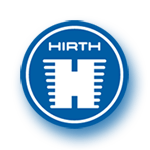Hirth
 | |
| Industry | Aerospace |
|---|---|
| Founded | 1920 |
| Founder(s) | Hellmuth Hirth |
| Products | Aircraft engines |
| Owner(s) | Hans Göbler |
| Website | www.hirth-engines.de |
Göbler-Hirthmotoren GmbH is an aircraft engine manufacturer based in Benningen, Germany.
History
The company was founded by Hellmuth Hirth in 1920 as Hellmuth Hirth Versuchsbau, renamed Leichtmetall-Werke GmbH and finally Elektronmetall GmbH as a manufacturer of light alloy engine components, including parts for aircraft engine components. In 1927, Hirth separated this part of the business, renaming it as Hirth Motoren GmbH, with the remainder becoming Mahle GmbH.
The first Hirth Motoren GmbH engine, the 4-cylinder inverted in-line HM 60, was released in 1931 and was fairly successful. An upgrade in the form of the HM 60R improved efficiency, and was followed by 6, 8 and 12-cylinder versions based on the same machinery. Over the next decade, Hirth became one of Germany's leading aero engine manufacturers.
Following Hirth's death in an aircraft crash in 1938, the Reichsluftfahrtministerium ("Reich aviation ministry") nationalised the company, and in 1941 it was merged with Heinkel to make Heinkel-Hirth. Although the existing engine series were continued, Heinkel also used the Hirth production facilities as a basis for work by Hans von Ohain on a series of jet engines as well, although for various reasons none was widely used.
Following World War II, this merger was dissolved, and Hirth was independent once again. Because of the prohibitions on German aviation during the Allied occupation, Hirth manufactured small stationary engines, as well as motors for snowmobiles. Eventually, Hirth returned to aircraft engine manufacturing in 1965, but in 1974 went into voluntary liquidation. The company was acquired by Hans Göbler, who returned it to making small two-stroke engines.
The beginnings of ultralight aviation in the 1980s created another opportunity to re-enter Hirth's original marketplace, and the company has been a notable builder of engines for these aircraft ever since.
Engines
Piston
- Hirth HM 60 - 4-cylinder inverted air-cooled inline aircraft engine, 80 hp (60 kW)
- Hirth HM 500 - 4-cylinder air-cooled inverted inline,
- Hirth HM 501 - 4-cylinder air-cooled inverted inline,
- Hirth HM 504 - 4-cylinder air-cooled inverted inline, 105 hp (78 kW)
- Hirth HM 506 - 6-cylinder air-cooled inverted inline, 165 hp (123 kW)
- Hirth HM 508 - 8-cylinder air-cooled inverted-V, 280 hp (209 kW)
- Hirth HM 512 - 12-cylinder air-cooled inverted-V, 400 hp (298 kW)
- Hirth HM 515 - 4-cylinder air-cooled inverted inline, 60 hp (45 kW)
- Hirth F-23 - 2-cylinder two stroke 50 hp (37 kW)
- Hirth F-30 - 4-cylinder two stroke 110 hp (82 kW)
- Hirth F-33 - 1-cylinder two stroke 28 hp (21 kW)
- Hirth F-36 - 1-cylinder two stroke 15 hp (11 kW)
- Hirth F-102 - 2-cylinder two stroke 26 hp (19 kW)
- Hirth F-263 - 2-cylinder two stroke 31 hp (23 kW)
- Hirth 2702 - 2-cylinder two stroke 40 hp (30 kW)
- Hirth 2703 - 2-cylinder two stroke 55 hp (41 kW)
- Hirth 2704 - 2-cylinder two stroke 53 hp (40 kW)
- Hirth 2706 - 2-cylinder two stroke 65 hp (48 kW)
- Hirth 3202 - 2-cylinder two stroke 55 hp (41 kW)
- Hirth 3203 - 2-cylinder two stroke 65 hp (48 kW)
- Hirth 3502 - 2-cylinder two stroke 60 hp (45 kW)
- Hirth 3503 - 2-cylinder two stroke 70 hp (52 kW)
- Hirth 3701 - 3-cylinder two stroke 100 hp (75 kW)
Turbine
- Heinkel HeS 1 - the first operational jet engine
- Heinkel HeS 3 - the first jet engine to fly
- Heinkel-Hirth HeS 30 - aka 006, perhaps the best early German design, cancelled for what turned out to be very bad reasons
- Heinkel-Hirth HeS 40 - "constant volume" combustion engine
- Heinkel-Hirth HeS 50 - ducted-fan unit for long-duration flight
- Heinkel-Hirth HeS 60 - HeS 50 with an additional turbine stage
- Heinkel-Hirth HeS 011 - advanced twin-spool design, only 19 test examples ever built
External links
| Wikimedia Commons has media related to Hirth aircraft engines. |
| |||||||||||
| ||||||||||||||